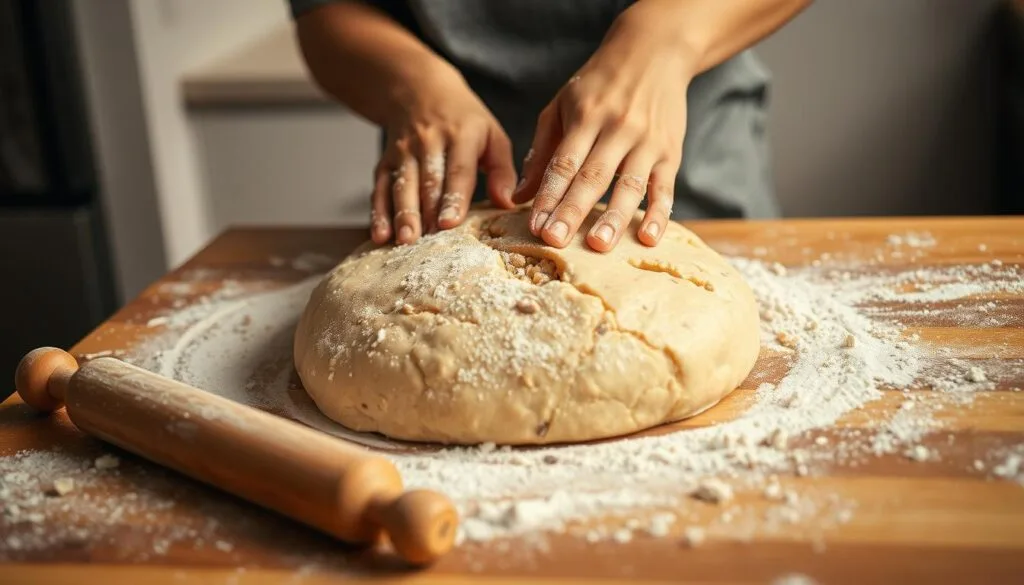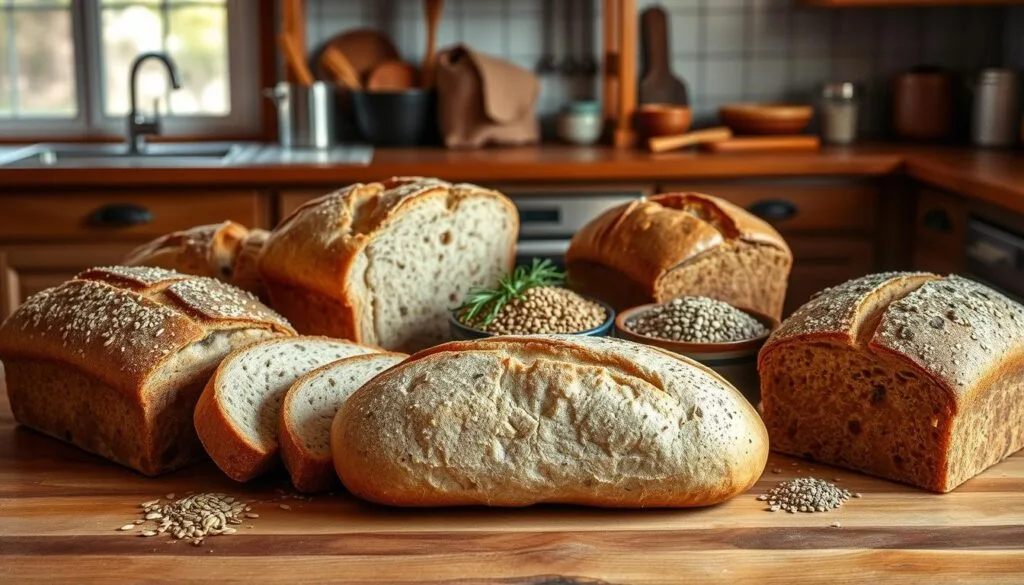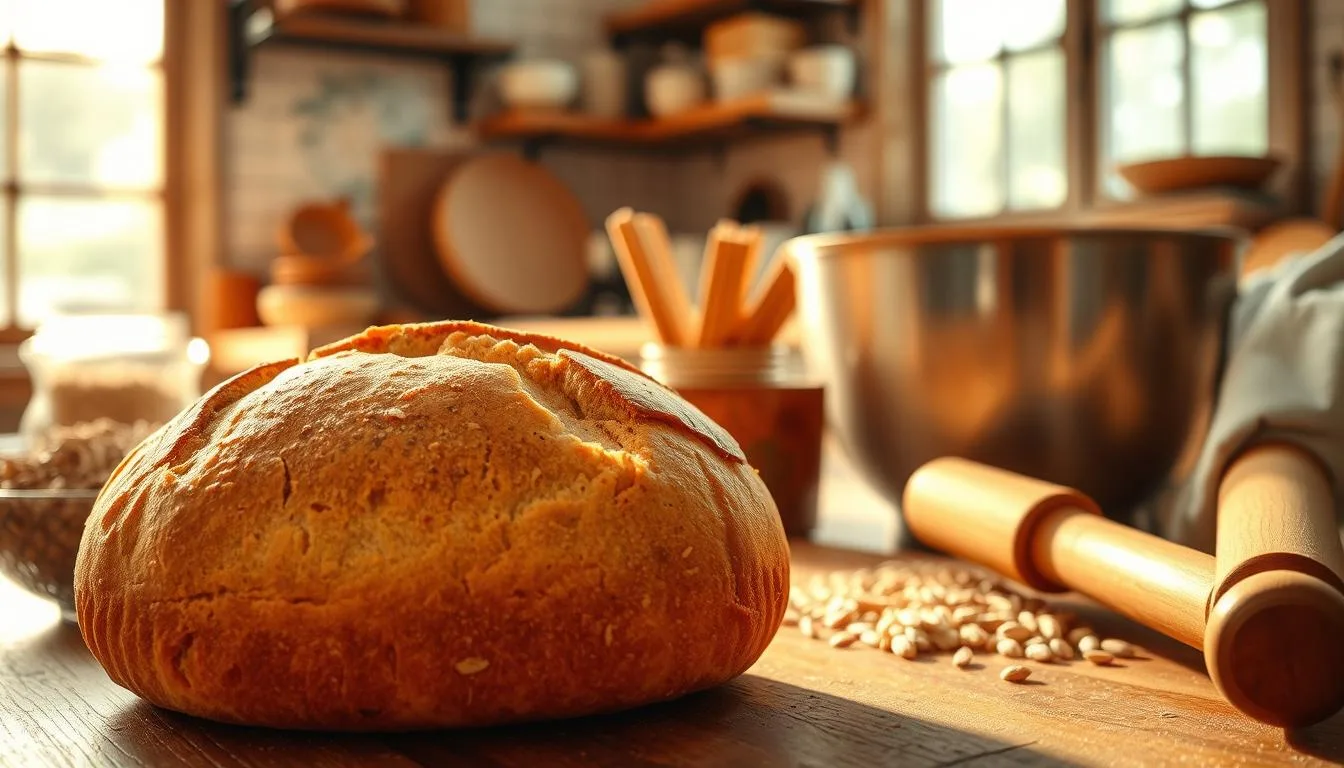Traditional Ezekiel bread recipe at home.
The smell of fresh bread is comforting in my kitchen. Finding the Ezekiel bread recipe was like discovering a treasure. It connects ancient wisdom with today’s healthy eating.
This homemade Ezekiel bread is more than just a recipe. It’s a journey that turns simple ingredients into a nutritious masterpiece.
Imagine baking a bread that’s not only tasty but also full of nutrients. The traditional Ezekiel bread recipe is more than food. It connects us to biblical nutrition that has lasted for generations.
Whether you’re into healthy baking or want to learn about traditional bread making, this guide is for you. It will show you how to make authentic Ezekiel bread that will change your home baking.
This homemade Ezekiel bread is special because of its sprouted grains and legumes. Unlike regular bread, it combines ingredients for amazing nutritional benefits. From start to finish, you’ll make a bread that changes everything.
Get ready for a baking adventure that nourishes your body and soul. You’ll dive into centuries of culinary tradition. Your journey to perfect Ezekiel bread begins here.
Understanding Ezekiel Bread and Its Biblical Origins
Ezekiel bread is a special whole grain bread recipe. It connects ancient nutrition with today’s health focus. This bread is more than a food choice; it’s a journey through history and tradition.
The story of Ezekiel bread starts with a biblical command. In the Book of Ezekiel, God told the prophet to make bread from grains and legumes. This was for a sustainable food source during hard times.
The Biblical Connection to Modern Bread Making
The recipe’s roots in the Bible show a smart nutritional plan. It uses a mix of ingredients for complete protein and essential nutrients. By making the bread as the original recipe suggests, bakers can offer:
- Complete protein combinations
- Balanced nutritional profile
- Ancient wheat and legume varieties
Nutritional Significance of Traditional Ingredients
The ingredients in traditional Ezekiel bread were chosen for their nutritional value. The mix usually includes:
| Ingredient | Nutritional Benefit |
|---|---|
| Wheat | Complex carbohydrates |
| Barley | Fiber and minerals |
| Millet | Protein and antioxidants |
| Lentils | Plant-based protein |
Historical Evolution of the Recipe
Ezekiel bread has changed a lot since its biblical start. Nutritionists and bakers have made it a staple for its nutritional value and historical importance.
Today, the recipe inspires those who want to connect with traditional nutrition. They enjoy a tasty, nutrient-rich bread.
Essential Ingredients for Authentic Ezekiel Bread
Making authentic homemade bread recipes needs the right ingredients. These ingredients should add nutrition and flavor to your vegan bread. Ezekiel bread is special because it’s made with many grains and legumes.
- Wheat berries
- Barley
- Millet
- Spelt
- Dried lentils
- Dried kidney beans
- Dried navy beans
“Let there be bread made of wheat, barley, beans, lentils, millet, and spelt.” – Biblical inspiration for Ezekiel bread
Each ingredient adds something special to your bread. Wheat berries give it protein. Lentils and beans add minerals and fiber. Together, they make a protein mix not often found in bread.
| Ingredient | Nutritional Benefit | Protein Content |
|---|---|---|
| Wheat Berries | High in fiber | 12-14g per cup |
| Lentils | Rich in iron | 18g per cup |
| Millet | Gluten-free alternative | 6g per cup |
When picking ingredients for your vegan bread, choose organic and sprouted grains. Sprouting makes nutrients more available and easier to digest. This makes your Ezekiel bread even healthier.
Required Kitchen Equipment and Tools
Making easy bread recipes like homemade Ezekiel bread needs the right kitchen tools. You start by knowing the essential equipment to turn whole grains into tasty, healthy bread.
Grain Mill Options and Alternatives
Grain processing is key when making homemade Ezekiel bread. You have several grain mill options:
- Electric grain mills for quick grinding
- Manual hand-crank mills for small batches
- Food processor as a temporary alternative
- Commercial grain grinding services
Baking Pans and Measuring Tools
Accuracy is important in easy bread recipes. Choose high-quality baking equipment:
| Equipment | Recommended Type | Purpose |
|---|---|---|
| Loaf Pan | 9×5 inch ceramic or glass | Even baking |
| Measuring Cups | Stainless steel | Accurate ingredient portions |
| Kitchen Scale | Digital with gram measurements | Precise ingredient weighing |
Mixing and Kneading Equipment
For successful homemade Ezekiel bread, consider these mixing tools:
- Stand mixer with dough hook
- Large mixing bowl
- Wooden spoon
- Silicone spatula
Pro tip: Your hands can be the most versatile kneading tool when making traditional bread recipes!
Step-by-Step Ezekiel Bread Recipe
Making your own ezekiel bread at home is simpler than you think. This recipe needs careful prep and special ingredients. It’s both healthy and tasty.
First, get all your ingredients and tools ready. Making great ezekiel bread takes precision and patience.
- Prepare your sprouted grains and legumes carefully
- Grind the sprouted ingredients into a fine flour
- Mix dry and wet ingredients thoroughly
- Knead the dough until smooth and elastic
- Allow proper rising time
- Bake at the correct temperature
Your healthy bread recipes should use whole grains and sprouted legumes. This mix gives Ezekiel bread a unique nutritional profile. It’s different from regular breads.
Key ingredients for your ezekiel bread recipe include:
- Wheat berries
- Barley
- Millet
- Lentils
- Soybeans
- Spelt
Professional bakers say to use freshly sprouted grains. This boosts nutritional value and flavor. Sprouting breaks down enzyme inhibitors, making nutrients easier to digest.
Remember, making Ezekiel bread takes practice. Don’t worry if your first try isn’t perfect. Each batch will improve your skills and understanding of this healthy bread-making process.
Sprouting and Preparing Grains and Legumes
Making a real sprouted grain bread recipe means learning how to sprout grains. This process turns regular grains into superfoods. It makes your bread taste better and easier to digest.
Sprouting is key for making traditional Ezekiel bread. It wakes up nutrients and breaks down harmful stuff. This makes grains healthier and easier to digest.
Proper Sprouting Techniques
To sprout grains right for your bread, follow these steps:
- Choose organic, raw whole grains
- Rinse grains well with cool water
- Soak grains in filtered water for 8-12 hours
- Drain and rinse grains every 8-12 hours
- Keep the room temperature steady
Timing and Storage Tips
Getting the right sprout needs careful timing. Each grain sprouts best at different times:
| Grain Type | Sprouting Time | Ideal Length |
|---|---|---|
| Wheat | 24-48 hours | 1/4 inch sprout |
| Barley | 36-48 hours | 1/8 inch sprout |
| Millet | 12-24 hours | 1/4 inch sprout |
Common Sprouting Mistakes to Avoid
When sprouting grains for your bread, avoid these mistakes:
- Don’t over-sprout, as it can make the bread taste bitter
- Avoid using chlorinated water
- Don’t store sprouted grains at the wrong temperatures
- Make sure to rinse grains often enough
Pro tip: Always use clean containers and keep things clean during sprouting. This helps avoid bad bacteria.
Mixing and Kneading Techniques

Learning to mix and knead is key for making easy breads like Ezekiel. This bread is special because it has sprouted grains and legumes. How you mix can change the bread’s texture and taste a lot.
Here are some tips for mixing:
- Start with room temperature ingredients for even mixing
- Use a stand mixer with a dough hook for consistent kneading
- Mix ingredients gradually to prevent clumping
- Knead until the dough becomes smooth and elastic
Pro tip: Ezekiel bread dough is different from regular bread. It’s denser and more nutritious, needing gentle but thorough kneading.
“The secret to great bread is in the technique, not just the ingredients” – Artisan Baker
Hand kneading is a hands-on way to make bread. Use a rhythmic motion to push and fold the dough. This builds gluten. Knead for 10-15 minutes to get the right texture for Ezekiel bread.
Practice makes perfect in bread making. Each batch will improve your skills. You’ll get better at mixing and kneading, becoming a bread-making pro.
Rising and Baking Instructions
Making homemade Ezekiel bread needs careful rising and baking steps. These steps turn your dough into a tasty, healthy loaf. It brings back the joy of traditional bread making.
Optimal Rising Conditions
Creating the best environment for your Ezekiel bread is key. Focus on three important things:
- Temperature: Keep it warm, between 75-80°F
- Humidity: Make sure it’s a bit moist to avoid dry dough
- Coverage: Use a damp cloth to keep the dough moist during rising
Temperature and Timing Guidelines
The rising process for your homemade Ezekiel bread goes like this:
- First Rise: Let the dough rest for 1-2 hours until it doubles
- Punch Down: Gently flatten the dough to spread yeast evenly
- Second Rise: Let it rise again for 30-45 minutes
Preheat your oven to 375°F for baking. Bake the bread for 35-40 minutes. It’s done when the crust is golden and sounds hollow.
Pro tip: Use a kitchen thermometer to ensure your bread reaches an internal temperature of 190-200°F for perfect doneness.
Storage Tips and Shelf Life
Making delicious homemade bread recipes means knowing how to store your fresh Ezekiel bread right. Your healthy bread recipes need the right care to keep their nutritional value and taste.
After baking your Ezekiel bread, you have a few ways to keep it fresh and tasty:
- Room Temperature Storage: Store your bread in a sealed plastic bag or bread box for up to 3-4 days
- Refrigeration: Keeps it fresh for about 5-7 days, but might change the bread’s texture a bit
- Freezing: Best for long-term storage, keeps quality for up to 3 months
When freezing your homemade bread, follow these important steps:
- Cool bread completely before packaging
- Wrap tightly in plastic wrap or freezer bag
- Remove as much air as possible to prevent freezer burn
- Label with date of freezing
Pro tip: Slice bread before freezing for easier thawing and portioning.
Signs your Ezekiel bread has gone bad include visible mold, unusual smell, or getting very hard. Always rely on your senses to check if bread is still fresh.
Proper storage is the secret to enjoying your homemade bread’s full flavor and nutritional benefits!
Variations of the Traditional Recipe
Trying out different ezekiel bread recipe variations can make baking more fun. It adds new flavors to this healthy bread. Whether you want to spice up your usual recipe or make a vegan version, these ideas will spark your creativity.

Customizing your Ezekiel bread lets you explore many tasty options. Each change keeps the bread’s nutritional value but brings in new tastes and textures.
Cinnamon Raisin Delight
Turn your classic ezekiel bread into a sweet breakfast by adding these:
- 2 tablespoons ground cinnamon
- 1/2 cup organic raisins
- 1 tablespoon honey or maple syrup (optional)
Mix the raisins and cinnamon into your dough. This makes a fragrant, slightly sweet bread great for morning toast.
Sesame Seed Enhancement
Make your vegan bread even better by adding sesame seeds. Just sprinkle raw or toasted sesame seeds on the dough before baking. This adds crunch and a nutty taste.
Gluten-Free Alternative
Make a gluten-free version of Ezekiel bread by using:
- Almond flour
- Buckwheat flour
- Quinoa flour
Adjust the liquid to keep the bread’s dense texture. Try mixing different flours to find your favorite gluten-free ezekiel bread.
Troubleshooting Common Baking Issues
Making perfect homemade Ezekiel bread can be tough, even for pros. Knowing common baking problems helps you make tasty, healthy loaves every time.
Density and Rising Problems
Dense loaves often come from wrong grain sprouting or yeast issues. Make sure your grains sprout fully and your yeast is fresh. Always check the yeast’s expiration date and test it before mixing.
- Verify grain sprouting time (2-3 days)
- Test yeast freshness with warm water
- Maintain consistent room temperature during rising
Dough Consistency Challenges
Getting the dough right is key for Ezekiel bread. If it’s too sticky or dry, tweak your ingredients carefully.
| Issue | Solution |
|---|---|
| Sticky Dough | Add small amounts of flour gradually |
| Dry Dough | Incorporate additional liquid (water or milk) incrementally |
| Uneven Rising | Ensure warm, draft-free environment |
Altitude and Climate Considerations
Baking in different places can change your results. High-altitude locations might need less leavening and more liquid. Places with low humidity might need more dough moisture.
Practice and patience are essential for mastering Ezekiel bread. Each try helps you learn more about your ingredients and methods.
Health Benefits and Nutritional Profile
Ezekiel bread is a nutritional powerhouse. It’s different from other whole grain breads because of its unique mix of nutrients. This makes it a great choice for a healthier diet.
The bread’s ingredients are carefully chosen. It combines grains and legumes to create a complete protein. This is something many other breads can’t offer.
- Complete protein with all nine essential amino acids
- High fiber content supporting digestive health
- Lower glycemic index compared to standard breads
- Rich in essential vitamins and minerals
The sprouting process boosts the bread’s nutritional value. Sprouted grains release more nutrients. This makes the bread easier to digest and packed with nutrients.
| Nutrient | Amount per Slice | Percentage Daily Value |
|---|---|---|
| Protein | 4g | 8% |
| Fiber | 3g | 12% |
| Magnesium | 40mg | 10% |
| Zinc | 1.2mg | 8% |
People with gluten sensitivities might find Ezekiel bread easier to digest. Its nutrient-rich composition makes it a top choice for healthier bread options.
Conclusion
Learning to make Ezekiel bread is more than just baking. It connects you to an ancient tradition that’s good for you. Your kitchen will become a place of creativity and healthy cooking.
Ezekiel bread is special because it’s made with whole grains and legumes. Every time you bake it, you’re making a meal that’s good for your body and soul. You can try different things to make it your own.
Your Ezekiel bread journey is just starting. Use it in your meals, like toast or sandwiches. As you get better, you’ll make a healthy staple that supports your health and cooking adventures.
Enjoy the art of making traditional bread. Let your Ezekiel bread recipe be a favorite in your kitchen. Your kitchen is now a place where you can make nutritious and delicious food.

